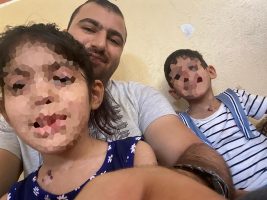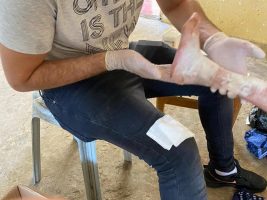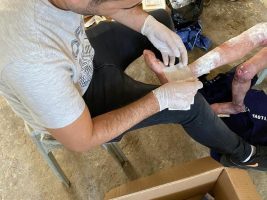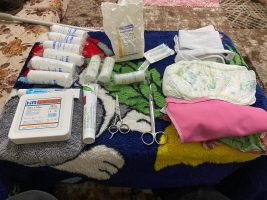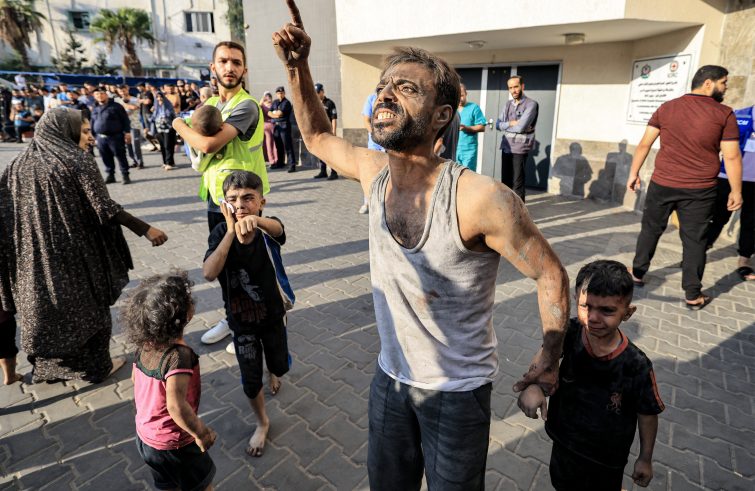
“The situation is extremely serious. It is impossible for us to access and deliver the medical equipment needed to treat these children. They need special treatments that are impossible to provide in the current circumstances.” An estimated seventy children with Epidermolysis Bullosa (EB), a rare genetic disease that causes blisters and lesions of the skin and internal mucous membranes, are among the thousands of children and their families caught up in the Gaza inferno.
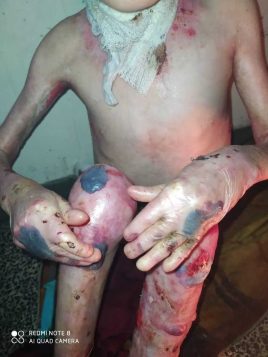 They are called “butterfly children” because they cannot be touched or hugged. Even a slight friction or touch can cause them to develop ulcers and third- or fourth-degree burns. Children as fragile as butterfly wings. In the most severe cases, the disease affects the hands and feet. The nails are missing, making it difficult for them to move their fingers, hands, feet. Their parents often refrain from hugging and kissing them to avoid causing more pain. A kiss and a hug are the only medicines available to children in Gaza today. But not for the butterfly children.
They are called “butterfly children” because they cannot be touched or hugged. Even a slight friction or touch can cause them to develop ulcers and third- or fourth-degree burns. Children as fragile as butterfly wings. In the most severe cases, the disease affects the hands and feet. The nails are missing, making it difficult for them to move their fingers, hands, feet. Their parents often refrain from hugging and kissing them to avoid causing more pain. A kiss and a hug are the only medicines available to children in Gaza today. But not for the butterfly children.
The children’s plight. Umar (fictitious name, Ed’.s note), a nurse working in a hospital in Gaza, involved in the “Help for the Butterfly Children” project launched at the end of October by the Catholic Parish of the Holy Family, the only Catholic church in the Strip with just over 100 faithful, with the support of Pro Terra Sancta, the NGO of the Custody of the Holy Land, described the plight of these children to SIR. Until 7 October, 38 of the 70 or so affected children in the Strip were being cared for under this project, and the volunteers, including Umar, went from house to house applying bandages and lotions, cleaning the children’s wounds and teaching their families how to wash and treat them. In the absence of a definitive cure, this “disease” can only be treated with remedies and treatments such as physiotherapy, special footwear, lotions, antibiotics and bandages to prevent the wounds from coming into contact with clothing and causing infection. All of this is now impossible in Gaza, which has been reduced to rubble, with almost all hospitals non-operational.
- Gaza, Bambini Farfalla (Foto Sir/Bellomo)
- Gaza, Bambini Farfalla (Foto Sir/Bellomo)
- Gaza, Bambini Farfalla (Foto Sir/Bellomo)
- Gaza, Bambini Farfalla (Foto Sir/Bellomo)
In search of the families. Umar is well aware of this, which is why she says: “Although the project is at a standstill because of the war, I am trying to contact all the families we had in our care. Unfortunately, only two replied to our messages. They told me that they had been forced by the Israeli army to leave their homes in the north and settle in the south of the Strip. Today they live in tents, virtually in the open air, exposed to the cold, in unhygienic and unsanitary conditions, with no one to look after their children who suffer from this syndrome. They cannot be visited because it is very dangerous to move around and there is a risk of being shot by snipers. The other families have not replied to our messages, I don’t know where they are, if they are still alive”.
“We are worried, these children will not be able to survive for long in these conditions.
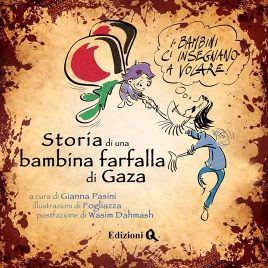 Gianna Pasini, a nurse from Brescia, Italy, who has been helping the butterfly children for a long time through the non-profit organisation PRCF-Italy, affiliated to the Palestinian NGO Palestine Children’s Relief Fund ( PCFR), which seeks to improve the quality of public health services in Palestine and to provide home medical assistance to families of children suffering from Epidermolysis Bullosa in Gaza, is committed to keeping in touch with these families. Pasini has written a book about this project in Arabic and Italian entitled ‘Storia di una bambina farfalla’ (‘Story of a Little Butterfly Girl’) (Q Editions). The book recounts the life of a butterfly girl living a life fraught with painful treatments, amidst school classes and dreams to be fulfilled (all the proceeds from the sale of the book will go to the Pro Terra Sancta project, Ed.’s note).
Gianna Pasini, a nurse from Brescia, Italy, who has been helping the butterfly children for a long time through the non-profit organisation PRCF-Italy, affiliated to the Palestinian NGO Palestine Children’s Relief Fund ( PCFR), which seeks to improve the quality of public health services in Palestine and to provide home medical assistance to families of children suffering from Epidermolysis Bullosa in Gaza, is committed to keeping in touch with these families. Pasini has written a book about this project in Arabic and Italian entitled ‘Storia di una bambina farfalla’ (‘Story of a Little Butterfly Girl’) (Q Editions). The book recounts the life of a butterfly girl living a life fraught with painful treatments, amidst school classes and dreams to be fulfilled (all the proceeds from the sale of the book will go to the Pro Terra Sancta project, Ed.’s note).
Serious conditions. “We have been trying to send some medicines from Italy to Gaza through the Red Crescent in the last few days,” he told SIR, “but we are encountering all kinds of bureaucratic obstacles. In the meantime, thanks also to Umar, attempts are being made to contact the families of the children who are beneficiaries of the project, but this is very difficult because the telephone lines are down. We understand that one family is stranded in the north because their son, who has EB, is physically unable to move. A mother has contacted us for help, but we don’t know exactly where she is. There are reports of another child in the project’s care whose condition is worsening, with wounds on his face due to lack of treatment. He is currently living in a tent with eight members of his family in the bombed-out area of Rafah. There is another young patient whose family has been torn apart. His father, a teacher, travelled from the north to the south to find accommodation for his family, but they have not yet been able to join him”.
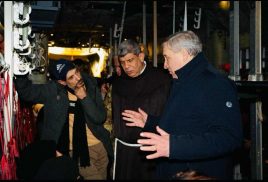 Despite the war, Umar and Gianna continue to dedicate themselves to the Butterfly Children because, as they say, “we want them to continue to fly”, perhaps even on one of our Air Force planes that bring so many sick and wounded children from Gaza to Italy.
Despite the war, Umar and Gianna continue to dedicate themselves to the Butterfly Children because, as they say, “we want them to continue to fly”, perhaps even on one of our Air Force planes that bring so many sick and wounded children from Gaza to Italy.

